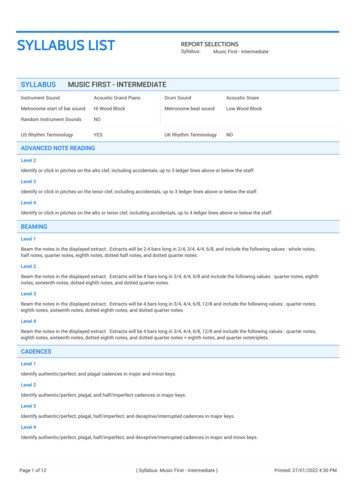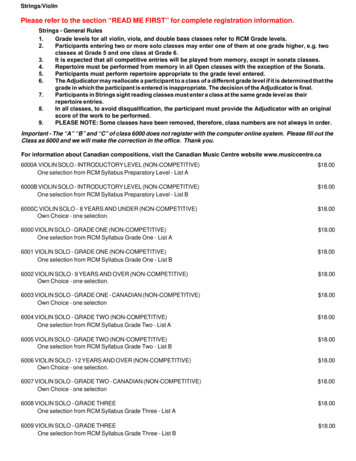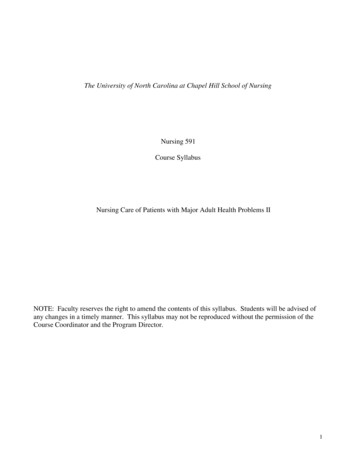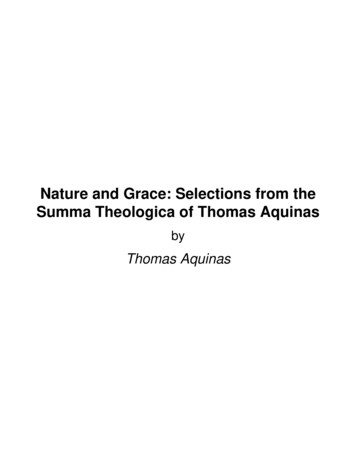
Transcription
SYLLABUS LISTSYLLABUSREPORT SELECTIONSSyllabus:Music First - IntermediateMUSIC FIRST - INTERMEDIATEInstrument SoundAcoustic Grand PianoDrum SoundAcoustic SnareMetronome start of bar soundHi Wood BlockMetronome beat soundLow Wood BlockRandom Instrument SoundsNOUS Rhythm TerminologyYESUK Rhythm TerminologyNOADVANCED NOTE READINGLevel 2Identify or click in pitches on the alto clef, including accidentals, up to 3 ledger lines above or below the staff.Level 3Identify or click in pitches on the tenor clef, including accidentals, up to 3 ledger lines above or below the staff.Level 4Identify or click in pitches on the alto or tenor clef, including accidentals, up to 4 ledger lines above or below the staff.BEAMINGLevel 1Beam the notes in the displayed extract. Extracts will be 2-4 bars long in 2/4, 3/4, 4/4, 6/8, and include the following values : whole notes,half notes, quarter notes, eighth notes, dotted half notes, and dotted quarter notes.Level 2Beam the notes in the displayed extract. Extracts will be 4 bars long in 3/4, 4/4, 6/8 and include the following values : quarter notes, eighthnotes, sixteenth notes, dotted eighth notes, and dotted quarter notes.Level 3Beam the notes in the displayed extract. Extracts will be 4 bars long in 3/4, 4/4, 6/8, 12/8 and include the following values : quarter notes,eighth notes, sixteenth notes, dotted eighth notes, and dotted quarter notes.Level 4Beam the notes in the displayed extract. Extracts will be 4 bars long in 3/4, 4/4, 6/8, 12/8 and include the following values : quarter notes,eighth notes, sixteenth notes, dotted eighth notes, and dotted quarter notes eighth notes, and quarter notetriplets.CADENCESLevel 1Identify authentic/perfect, and plagal cadences in major and minor keys.Level 2Identify authentic/perfect, plagal, and half/imperfect cadences in major keys.Level 3Identify authentic/perfect, plagal, half/imperfect, and deceptive/interrupted cadences in major keys.Level 4Identify authentic/perfect, plagal, half/imperfect, and deceptive/interrupted cadences in major and minor keys.Page 1 of 12( Syllabus: Music First - Intermediate )Printed: 27/01/2022 4:30 PM
CHORD PROGRESSIONSLevel 1Identify chords in a chord progression containing : major keys - I, IV, V and V7, and minor keys - i, iv, V and V7.Level 2Identify chords in a chord progression containing : Major Keys: I, I6, IV, IV6, V, V6.Minor Keys: i, i6, iv, iv6, V, V6.Level 3Introducing the vi chord in major keys, including chords I, ii, IV, V, V7 and vi in root position.Level 4Introducing the VI chord in minor keys. 3 bar progressions in minor keys, including chords i, ii dim, iv, V, V7 and VI in root position.CHORDSLevel 1Write major, minor, diminished and augmented chords, in keys with up to 3 #s and bs, on the treble or bass clef.Level 2Write major, minor, diminished, augmented and dominant 7th chords, in keys with up to 3 #s and bs, on the treble or bass clef.Level 3Identify or write major and minor (root position and 1st inversion), dominant 7th, augmented and diminished chords, in major and minorkeys with up to 4 #s and bs, on the treble or bass clef.Level 4Identify or write major and minor (all inversions), dominant 7th, augmented, and diminished chords, in major and minor keys with up to 5 #sand bs, on the treble or bass clef.COMPLETE THE BARLevel 1Complete the bar with rhythmic values down to eighth notes including rests, and dotted quarter notes. Included meters are 6/8, and 4/4.Level 2Complete the bar with rhythmic values down to sixteenth notes including rests, plus triplets and dotted eighth notes. Included meters are3/8, 6/8, 2/4, 3/4 and 4/4.COMPOSERSLevel 1Identify the lifespan, birth country or musical period of various composers including Bach, Mozart, Beethoven, Grieg, Tchaikovsky, Handel,Strauss, Schubert, Verdi, Vivaldi and Wagner.Level 2Identify the lifespan, birth country or musical period of various composers including Bizet, Chopin, Debussy, Elgar, Liszt, Mendelssohn,Puccini, Purcell, Rimsky-Korsakov, Rossini, Sarasate, Sousa, Von-Weber and Smetana.Level 3Identify the lifespan, birth country or musical period of various composers including Boccherini, Faure, Leoncavallo, Mouret, Mussorgsky,Offenbach, Pachelbel, Paganini, Ponchielli and Satie.Page 2 of 12( Syllabus: Music First - Intermediate )Printed: 27/01/2022 4:30 PM
CONCEPTSLevel 1Define the following musical concepts : Time signature, anacrusis, staff, ledger lines, measures/bars, bar lines, beat, rests, double bar, clef,sharp, flat natural, key signature, theme and variations, intervals, ties, glissando, phrase, dynamics, scale, chord, arpeggio, enharmonic notes,chromatic scale, soli.Level 2Define the following musical concepts : Tonic, dominant, subdominant, submediant, register, articulation, cadence, timbre, triad, inversion,supertonic, leading note, coda, monophonic texture, homophonic texture, polyphonic texture, ornament, harmony.Level 3Define the following musical concepts : Tonic, dominant, subdominant, submediant, register, articulation, cadence, timbre, triad, inversion,supertonic, leading note, coda, monophonic texture, homophonic texture, polyphonic texture, ornament, authentic/perfect cadence, plagalcandence, pentatonic, syncopation, triplet, improvisation, harmony.Level 4Define the following musical concepts : binary form, ternary form, rondo form, diatonic, dissonance, consonance, interlude, bridge, verseand chorus form, tritone, motif, cadenza, resolution, atonal, passing note, obbligato, auxiliary note, compound interval.DIATONIC CHORDSLevel 1Identify or click in tonic, subdominant, and dominant chords in all inversions, in major and minor keys with up to 3 #'s and b's, on the trebleor bass clef.Level 2Identify or click in tonic, subdominant, dominant 7th and dominant chords in all inversions, in major and minor keys with up to 3 #'s and b's,on the treble or bass clef.Level 3Identify or click in tonic, subdominant, submediant, dominant 7th and dominant chords in all inversions, in major and minor keys with up to4 #'s and b's, on the treble or bass clef.Level 4Identify or click in tonic, supertonic, subdominant, submediant, dominant 7th and dominant chords in all inversions, in major and minor keyswith up to 5 #'s and b's, on the treble or bass clef.DRUM STICKINGLevel 1Drum sticking combinations, containing 4 eighth notes, leading with the left or right hand, and including single paradiddles and tripleparadiddles. Patterns are to be tapped twice. Tempo 60.Level 2Drum stickings, containing 4 sixteenth notes, leading with the left or right hand, and including single paradiddles and triple paradiddles.Patterns are to be tapped four times. Tempo 50.Level 3Drum sticking combinations, containing 4 sixteenth notes, leading with the left or right hand, and including single paradiddles and tripleparadiddles. Patterns are to be tapped twice. Tempo 60.Level 4Drum stickings, containing 3 eighth note triplets, leading with the left or right hand, and including double paradiddles and paradiddlediddles. Patterns are to be tapped four times. Tempo 60.Page 3 of 12( Syllabus: Music First - Intermediate )Printed: 27/01/2022 4:30 PM
DRUM STYLESLevel 1Tap the displayed ride cymbal, kick drum, hi -hat, cowbell, or snare drum part, along with a mambo, cha-cha, bossa nova or hih-hop drumpattern. The focus of this level is on eighth notes.Level 2Tap the displayed ride cymbal, kick drum, hi -hat, cowbell, or snare drum part, along with a merengue, 16th note, calypso or samba drumpattern. The focus of this level is on sixteenth notes.Level 3Tap the displayed ride cymbal, kick drum, hi -hat, cowbell, or snare drum part, along with a 12/8 drum pattern. The focus of this level is on12/8 time.Level 4Tap the displayed ride cymbal, kick drum, hi -hat, cowbell, or snare drum part, along with a jazz, 12/8, or shuffle drum pattern. The focus ofthis level is on triplets and 12/8 time.Tap the displayed ride cymbal, kick drum, hi -hat, cowbell, or snare drum part, along with a basic rock, waltz, bossa nova, cha cha, jazz, hiphop, dance, mambo, samba, calypso, merengue, 16th note, 12/8, or shuffle drum pattern.ENHARMONIC NOTESLevel 1Identify the enharmonic equivalents of the following pitches : C#, Db, D#, Eb, F#, Gb, G#, Ab, A#, Bb. No double accidentals will be displayedas possible answers.Level 2Identify the enharmonic equivalents of the following pitches : Cb, C, C#, Db, D#, Eb, E, E#, Fb, F, F#, Gb, G#, Ab, A#, Bb, B, B#. No doubleaccidentals will be displayed as possible answers.Level 3Identify the enharmonic equivalents of the following pitches : Cb, C, C#, Db, D, D#, Eb, E, E#, Fb, F, F#, Gb, G, G#, Ab, A, A#, Bb, B, B#. Doubleaccidentals will be displayed as possible answers.GUITAR SYMBOLSLevel 1Recognition of E, A, and D major chord symbols.Level 2Recognition of E, A, and D major, F5, Bb5, and Eb5 chord symbols.Level 3Recognition of C, G, F, E, A, and D major, F5, Bb5, and Eb5 chord symbols.Level 4Recognition of C, G, F, E, A, and D major, F5, Bb5, Eb5, E7, A7, D7, C7 and B7 chord symbols.INSTRUMENT KEYSLevel 1Identify the keys of the following instruments : Flute, clarinet, trumpet, violin, double bass, piano, cornet, viola, guitar, piccolo, oboe, bassclarinet, alto saxophone, tenor saxophone, cello.Level 2Identify the keys of the following instruments : Flute, clarinet, trumpet, violin, double bass, piano, cornet, viola, guitar, piccolo, oboe, bassclarinet, alto saxophone, tenor saxophone, cello, bassoon, french horn, flugelhorn.Page 4 of 12( Syllabus: Music First - Intermediate )Printed: 27/01/2022 4:30 PM
Level 3Identify the keys of the following instruments : Flute, clarinet, trumpet, violin, double bass, piano, cornet, viola, guitar, piccolo, oboe, bassclarinet, alto saxophone, tenor saxophone, cello, bassoon, french horn, flugelhorn, tuba, baritone saxophone, soprano saxophone.Level 4Identify the keys of the following instruments : Flute, clarinet, trumpet, violin, double bass, piano, cornet, viola, guitar, piccolo, oboe, bassclarinet, alto saxophone, tenor saxophone, cello, bassoon, french horn, flugelhorn, piccolo trumpet, alto clarinet, tuba, baritone saxophone,soprano saxophone.INSTRUMENT KNOWLEDGELevel 1Questions relating to instrument family, playing position, sound production and construction material, for the following instruments : flute,piccolo, oboe, bassoon, clarinet, bass clarinet, alto saxophone, tenor saxophone, baritone saxophone, trumpet, trombone, French horn, tuba,side drum, timpani, triangle, electric bass, cymbals, bass drum and tambourine, violin, cello, double bass.Level 2Questions relating to instrument family, playing position, sound production, shape, and construction material, for the following instruments :flute, piccolo, oboe, bassoon, clarinet, bass clarinet, alto saxophone, tenor saxophone, baritone saxophone, trumpet, trombone, French horn,tuba, side drum, timpani, triangle, electric bass, cymbals, bass drum, tambourine, violin, cello, double bass, guitar, piano, and viola.Level 3Questions relating to sound production, clef, shape, number of strings, and construction material, for the following instruments : flute,piccolo, oboe, bassoon, clarinet, bass clarinet, alto saxophone, tenor saxophone, baritone saxophone, trumpet, trombone, French horn, tuba,side drum, timpani, triangle, electric bass, cymbals, bass drum, tambourine, violin, cello, double bass, guitar, piano, and viola.Level 4Questions relating to sound production, clef, shape, number of strings, string tuning, changing pitch, for the following instruments : flute,piccolo, oboe, bassoon, clarinet, bass clarinet, alto saxophone, tenor saxophone, baritone saxophone, trumpet, trombone, French horn, tuba,side drum, timpani, triangle, electric bass, cymbals, bass drum, tambourine, violin, cello, double bass, guitar, piano, and viola.INSTRUMENT RANGELevel 1Identify the concert pitch range of the following instruments : Flute, clarinet, piano, trumpet, violin, alto saxophone, trombone, and guitar.Level 2Identify the concert pitch range of the following instruments : Flute, clarinet, piano, trumpet, violin, alto saxophone, trombone, oboe, tenorsaxophone, cello, and guitar.Level 3Identify the concert pitch range of the following instruments : Flute, clarinet, piano, trumpet, violin, alto saxophone, trombone, harp, doublebass, piccolo, oboe, tenor saxophone, cello, guitar, bass clarinet, bassoon, and French horn.Level 4Identify the concert pitch range of the following instruments : Flute, clarinet, piano, trumpet, violin, alto saxophone, trombone, harp, doublebass, piccolo, oboe, tenor saxophone, recorder, cello, timpani, organ, guitar, cornet, bass clarinet, bassoon, soprano saxophone, baritonesaxophone, glockenspiel, xylophone and French horn.INSTRUMENT RECOGNITIONLevel 1Identify the following instruments : Flute, piccolo, oboe, clarinet, bass clarinet, alto sax, baritone sax, tenor sax, trumpet, French horn,trombone, bassoon, electric bass, tuba, bass drum, congas, cow bell, cymbals, snare/side drum, tambourine, timpani, triangle, xylophone,drum kit, violin, double bass.Page 5 of 12( Syllabus: Music First - Intermediate )Printed: 27/01/2022 4:30 PM
Level 2Aurally identify the following instruments : piano, organ, flute, piccolo, clarinet, alto saxophone, oboe, tenor saxophone, baritone saxophone,trumpet, trombone, tuba, French horn, violin, cello, harp, electric bass, double bass, electric guitar, accoustic guitar, cowbell, timpani, drumkit, triangle, xylophone, bass drum, kick drum, cymbal, snare drum, tambourine and congas.Level 3Aurally identify the following instruments : piano, organ, flute, piccolo, clarinet, recorder, alto saxophone, oboe, tenor saxophone, bassoon,baritone saxophone, trumpet, trombone, tuba, French horn, violin, cello, harp, electric bass, double bass, electric guitar, accoustic guitar,cowbell, timpani, drum kit, triangle, xylophone, bass drum, kick drum, shaker, cymbal, snare drum, tambourine and congas.Level 4Aurally identify the following instruments : piano, harpsichord, organ, flute, piccolo, clarinet, recorder, alto saxophone, oboe, tenorsaxophone, bassoon, baritone saxophone, trumpet, trombone, tuba, French horn, violin, cello, harp, electric bass, double bass, electric guitar,accoustic guitar, cowbell, timpani, drum kit, triangle, xylophone, glockenspiel, vibraphone, agogo, bass drum, kick drum, bongos, shaker,cymbal, gong, snare drum, tambourine, viola, and congas.INSTRUMENT TRANSPOSITIONLevel 1Identify the correctly transposed pitch, or identify the concert pitch of a given written pitch, for one of the following instruments : piccolo,double bass, trumpet, clarinet, and tenor saxophone. The instrument key is given.Level 2Identify the correctly transposed pitch, or identify the concert pitch of a given written pitch, for one of the following instruments : piccolo,double bass, trumpet, clarinet, alto saxophone and tenor saxophone. The instrument key is given.Level 3Transpose the given concert pitch extract for one of the following instruments : Piccolo, clarinet, trumpet, tenor saxophone, bass clarinet,alto saxophone and double bass.Level 4Transpose the given concert pitch extract for one of the following instruments : Piccolo, clarinet, trumpet, tenor saxophone, bass clarinet,alto saxophone, baritone saxophone and double bass.INTERVALSLevel 1Write or identify the interval on the treble or bass clef. Includes simple ascending intervals of a perfect unison, perfect 4th, perfect 5th,perfect octave, major 2nd, major 3rd, and minor 3rd, starting from the tonic, in major and minor keys with up to 3 #s and bs.Level 2Write or identify the interval on the treble or bass clef. Includes simple ascending intervals of a perfect unison, perfect 4th, perfect 5th,perfect octave, major 2nd, major 3rd, major 6th, major 7th, minor 2nd and minor 3rd, starting from the tonic, in major and minor keys with upto 3 #s and bs.Level 3Identify or write the interval on the treble or bass clef. Includes all simple chromatic ascending intervals, starting from the tonic, in majorand minor keys with up to 4 # and b.Level 4Identify or write the interval on the treble or bass clef. Includes all simple chromatic ascending and descending intervals, starting from thetonic, in major and minor keys with up to 5 # and b.Page 6 of 12( Syllabus: Music First - Intermediate )Printed: 27/01/2022 4:30 PM
KEY SIGNATURESLevel 1Identify the key signature on the treble or bass clef, or identify the relative major/minor key, for major and minor keys with up to 3 #s and bs.Level 2Identify or write the key signature on the treble or bass clef, or identify the relative major/minor key, for major and minor keys with up to 3 #sand bs.Level 3Identify or write the key signature on the treble or bass clef, or identify the relative major/minor key, for major and minor keys with up to 4 #sand bs.Level 4Identify or click in the key signature on the treble or bass clef, or identify the relative major/minor key, for major and minor keys with up to 5#s and bs.METER RECOGNITIONLevel 1Identify the time signature of the given extract, enter the barlines, or define the displayed meter. Extracts will be 2-4 bars long in 2/4, 3/4,4/4, 6/8, and include the following values : whole notes, half notes, quarter notes, eighth notes, plus their rest values, dotted half notes, anddotted quarter notes.Level 2Identify the time signature of the given extract, or enter the barlines. Extracts will be 4 bars long in 2/4, 3/4, 4/4, and 6/8, and include thefollowing values : whole notes, half notes, quarter notes, eighth notes, sixteenth notes, plus their rest values, dotted half notes, dottedquarter notes, and dotted eighth notes.Level 3Identify the time signature of the given extract, or enter the barlines. Extracts will be 4 bars long in 2/4, 3/4, 4/4, 6/8, and 12/8 and includethe following values : whole notes, half notes, quarter notes, eighth notes, sixteenth notes, plus their rest values, dotted half notes, dottedquarter notes, and dotted eighth notes.Level 4Identify the time signature of the given extract, or enter the barlines. Extracts will be 4 bars long in 2/4, 3/4, 4/4, 6/8, and 12/8 and includethe following values : whole notes, half notes, quarter notes, eighth notes, sixteenth notes, plus their rest values, dotted half notes, dottedquarter notes, dotted eighth notes, plus triplet quarter notes and eighth notes.METER TRANSPOSITIONLevel 3Transpose the rhythm from simple time to its equivalent compound meter or vice versa. Includes 2/4, 6/8, 3/4, 9/8, 4/4, 12/8 with rhythmicvalues down to the beat value. This level also includes some general knowledge questions on simple - compound meter transpositions.Level 4Transpose the rhythm from simple time to its equivalent compound meter or vice versa. Includes 2/4, 6/8, 3/4, 9/8, 4/4, 12/8 plus tripletsand duplets.NOTE READINGLevel 1Identify or write pitches on the treble and bass clef, including single accidentals, up to 2 ledger lines above or below the staff.Level 2Identify or write pitches on the treble and bass clef, including single accidentals, up to 3 ledger lines above or below the staff.Level 2 - TrebleIdentify or write pitches on the treble clef, up to 3 ledger lines above or below the staff.Page 7 of 12( Syllabus: Music First - Intermediate )Printed: 27/01/2022 4:30 PM
Level 2 - BassIdentify or write pitches on the bass clef, up to 3 ledger lines above or below the staff.ORNAMENTSLevel 1Identify the following ornaments : trill, turn, upper and lower mordent, acciaccatura, appoggiatura.Level 2Select which of the possible answers displays how the given ornament would be performed. Included ornaments are : trill, turn,acciaccatura, appoggiatura.Level 3Select which of the possible answers displays how the given ornament would be performed. Included ornaments are : trill, turn,acciaccatura, appoggiatura plus accidentals.Level 4Select which of the possible answers displays how the given ornament would be performed. Included ornaments are : trill, turn, upper andlower mordent, acciaccatura, appoggiatura, plus accidentals.PERIODSLevel 1Identify distinguishing features of the contemporary, impressionist, classical and romantic periods.Level 2Identify distinguishing features of the baroque, renaissance, contemporary, impressionist, classical and romantic periods.Level 3Identify distinguishing features of the medieval, modernist, baroque, renaissance, contemporary, impressionist, classical and romanticperiods.PIANO KEYBOARDLevel 1Identify the note names on a one octave piano keyboard. Includes naturals, flats and sharps.POLYRHYTHMSLevel 1Tap 3:2, 2:3 rhythms - one part. Each rhythm will be tapped 4 times.Level 2Tap 3:2, 2:3 rhythms - both parts. Each rhythm will be tapped 4 times.Level 3Tap 3:4, 4:3 rhythms - one part. Each rhythm will be tapped 4 times.Level 4Tap 3:4, 4:3 rhythms - both parts. Each rhythm will be tapped 4 times.Page 8 of 12( Syllabus: Music First - Intermediate )Printed: 27/01/2022 4:30 PM
RHYTHM COUNTINGLevel 16/8: (1 - la - li): Third of the beat valueWrite the rhythm counting (1-la-li etc) for the displayed excerpt. Excerpts may include rests, and rhythmic values down to 1/3 of the beatvalue in 6/8.Level 22/4, 3/4, 4/4: Quarter of the beat valueWrite the rhythm counting (1e&a etc) for the displayed excerpt. Excerpts may include rests, an anacrusis, and rhythmic values down to 1/4of the beat value (including mixed groupings) in 2/4, 3/4 or 4/4.Level 36/8: (1 - la - li): Sixth of the beat value, 3/4, 4/4: Quarter of the beat valueWrite the rhythm counting (1-la-li etc) for the displayed excerpt. Excerpts may include rests, and rhythmic values down to 1/6 of the beatvalue in 6/8, plus rhythmic values down to a 1/4 of the beat including dotted eighth notes and syncopation in 3/4 and 4/4.Level 42/4, 3/4, 4/4: TripletsWrite the rhythm counting (1e&a etc) for the displayed excerpt. Excerpts may include rhythmic values down to half of the beat value plustriplets in 2/4, 3/4 or 4/4.Level 4a2/4, 3/4, 4/4: Triplets (Using the 1-la-li etc counting method)Write the rhythm counting (1e&a etc) for the displayed excerpt. Excerpts may include rhythmic values down to half of the beat value plustriplets in 2/4, 3/4 or 4/4.RHYTHM NOTATIONLevel 1Identify the displayed rhythmic value. Included values are : whole notes, half notes, quarter notes, eighth notes, dotted half notes, dottedquarter notes and their rest values.Level 2Identify the displayed rhythmic value. Included values are : whole notes, half notes, quarter notes, eighth notes, sixteenth notes, and theirrest and dotted values.RHYTHM SUMSLevel 1Add the displayed rhythmic values. Values down to eighth notes including dotted quarter notes.Level 2Add the displayed rhythmic values. Values down to sixteenth notes.Level 3Add the displayed rhythmic values. Values down to sixteenth notes including dotted eighth notes.Page 9 of 12( Syllabus: Music First - Intermediate )Printed: 27/01/2022 4:30 PM
RHYTHM TAPPINGLevel 1Tap the displayed rhythm. Extracts will be 3-4 bars long in 2/4, 3/4, 4/4, 6/8, and include the following values : whole notes, half notes,quarter notes, eighth notes, plus their rest values, dotted half notes, and dotted quarter notes.Level 1 - No RestsTap the displayed rhythm. Extracts will be 3-4 bars long in 2/4, 3/4, 4/4, 6/8, and include the following values : whole notes, half notes,quarter notes, eighth notes, plus dotted half notes, and dotted quarter notes.Level 2Tap the displayed rhythm. Extracts will be 4 bars long in 2/4, 3/4, 4/4, and 6/8, and include the following values : whole notes, half notes,quarter notes, eighth notes, sixteenth notes, dotted half notes, dotted quarter notes, dotted eighth notes, plus their rest values.Level 3Tap the displayed rhythm. Extracts will be 4 bars long in 2/4, 3/4, 4/4, 6/8, 12/8 and include the following values : whole notes, half notes,quarter notes, eighth notes, sixteenth notes, dotted half notes, dotted quarter notes, dotted eighth notes, plus their rest values.Level 4Tap the displayed rhythm. Extracts will be 4 bars long in 2/4, 3/4, 4/4, 6/8, 12/8 and include the following values : whole notes, half notes,quarter notes, eighth notes, sixteenth notes, dotted half notes, dotted quarter notes, dotted eighth notes, plus their rest values, triplet eighthnotes, and triplet quarter notes.RHYTHMIC SUBDIVISIONLevel 1Identify the relative durations of 2 rhythmic values. Included values are : whole notes, half notes, quarter notes, eighth notes, dotted halfnotes, dotted quarter notes and their rest values.Level 2Identify the relative durations of 2 rhythmic values. Included values are : whole notes, half notes, quarter notes, eighth notes, sixteenthnotes, and their rest and dotted values.SCALE DEGREESLevel 1Identify the degree of a single given pitch. All scale degrees will be included in major keys with up to 3 #s and bs.Level 2Identify the degree of a single given pitch. All scale degrees will be included in major and minor keys with up to 3 #s and bs.Level 3Identify the degree of a single given pitch. All scale degrees will be included in major and minor keys with up to 4 #s and bs.Level 4Identify the degree of a single given pitch. All scale degrees will be included in major and minor keys with up to 5 #s and bs.SCALESLevel 1Identify the following ascending scales on the treble or bass clef, in keys with up to 3 #s and bs : major, natural minor, harmonic minor,melodic minor. The key signature will not be displayed.Level 2Identify the following ascending and descending scales on the treble or bass clef, in keys with up to 3 #s and bs : major, natural minor,harmonic minor, melodic minor, major pentatonic, minor pentatonic, chromatic. The key signature will not be displayed.Page 10 of 12( Syllabus: Music First - Intermediate )Printed: 27/01/2022 4:30 PM
Level 3Write the following ascending and descending scales on the treble or bass clef, in keys with up to 4 #s and bs : major, natural minor,harmonic minor, melodic minor, major pentatonic, minor pentatonic, chromatic. The key signature will not be displayed.Level 4Write the following ascending and descending scales on the treble or bass clef, in keys with up to 5 #s and bs : major, natural minor,harmonic minor, melodic minor, major pentatonic, minor pentatonic, chromatic, mixolydian, dorian. The key signature will not be displayed.SCORE READINGLevel 1Mixed score reading questions based on a short excerpt. Questions may include note reading, intervals (by size only), rhythm, scaledegrees, scales, tones & semitones, terms & symbols, meter and triads. Treble or bass clefs, major and minor keys with up to 3 sharps/flats,2/4, 3/4, 4/4 or 6/8, with rhythmic values down to simple time: half the beat value including rests and dotted beat values, compound time:one third the beat value including rests and dotted beat values.Level 2Mixed score reading questions based on a short excerpt. Questions may include note reading, intervals (by size only), rhythm, scaledegrees, scales, tones & semitones, terms & symbols, meter and triads. Treble or bass clefs, major and minor keys with up to 3 sharps/flats,2/4, 3/4, 4/4 or 6/8, with rhythmic values down to simple time: one quarter the beat value including rests and dotted beat values, compoundtime: one 6th the beat value including rests and dotted beat values.Level 4Mixed score reading questions based on a short excerpt. Questions may include note reading, intervals (by size only), rhythm, scaledegrees, scales, tones & semitones, terms & symbols, meter and triads. Treble or bass clefs, major and minor keys with up to 3 sharps/flats,2/4, 3/4, 4/4 or 6/8, with rhythmic values down to simple time: one quarter the beat value including rests, dotted beat values and triplets,compound time: one 6th the beat value including rests and dotted beat values.SOLFEGE SIGNINGLevel 1Identify Solfege hand signs based off the following scale degrees : Do, Re, Mi, Fa, So, La, Ti.SYMBOLSLevel 1Identify the following musical symbols : barline, piano, forte, natural, crescendo, decrescendo, repeat, fermata, repeat, sharp, flat, staff, trebleclef, bass clef, slur, tie, glissando, pianissimo, fortissimo, mezzo piano, mezzo forte, repeat barline, Da Capo, double barline, metronomemark, common time, accent, breath mark, coda sign, DS, staccato, tenuto, 1st time bar, 2nd time bar.Level 2Identify the following musical symbols : Da Capo, double barline, metronome mark, common time, accent, breath mark, coda sign, DS,staccato, tenuto, marcato accent, pedal up, trill, turn, mordent, appogiatura, acciaccatura.Level 3Identify the following musical symbols : Da Capo, double barline, metronome mark, common time, accent, breath mark, coda sign, DS,staccato, tenuto, marcato accent, pedal up, trill, turn, mordent, appogiatura, acciaccatura, double sharp, double flat, triplet, inverted turn,inverted mordent, semi staccato accent.Level 4Identify the following musical symbols : Da Capo, double barline, metronome mark, common time, accent, breath mark, coda sign, DS,staccato, tenuto, marcato accent, pedal up, trill, turn, mordent, appogiatura, acciaccatura, double sharp, double flat, triplet, inverted turn,inverted mordent, semi staccato accent, tremolo, up bow, down bow, staccatissimo, rinforzando, caesura, arpeggiate, sforzando.Page 11 of 12( Syllabus: Music First - Intermediate )Printed: 27/01/2022 4:31 PM
TERMSLevel 1Define the following terms : andante, adagio, allegro, forte, piano, mezzo forte, crescendo, decrescendo, moderato, da capo al fine, dal segno,simile, largo, mezzo piano, legato, staccato, molto, sempre, poco a poco, accelerando, ritenuto, a tempo, andantino, lento, vivo, vivace, menomosso, fortissimo, pianissimo, semplice, dolce, glissando, animato, tenuto.Level 2Define the following terms : andante, adagio, allegro, forte, piano, mezzo forte, crescendo, decrescendo, moderato, da capo al fine, dal segno,simile, largo, mezzo piano, leg
Page 1 of 9 ( Syllabus: Music First - Intermediate ) Printed: 17/08/2020 10:57 AM Level 4 Identify authentic/perfect, plagal










